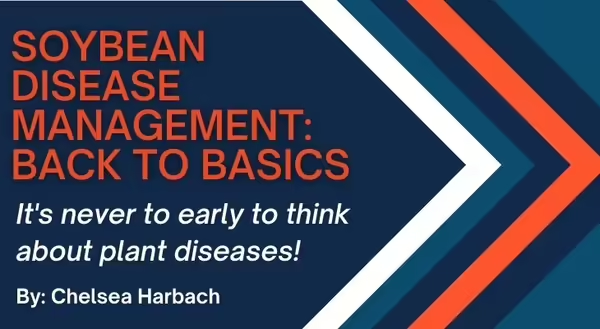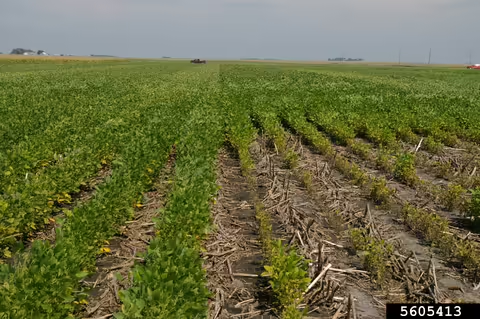
It’s never too early to think about plant diseases!
There are few sure things in this great wide world of ours. The sun rises in the east and sets in the west, gravity holds us down to the earth, and living things are susceptible to pests and pathogens.
When you put your beans out in the field, there are numerous plant diseases than can wreak havoc in your field. However, the incidence and severity of a disease can be highly variable, and management can be tricky.
Let's talk about the basics of soybean disease management. And I mean basic. The fundamentals that I remember learning in my introductory plant pathology course can be helpful when thinking about plant disease prevention and management.
The plant disease triangle
This concept demonstrates the three variables that must be present simultaneously in space and time for a disease to develop and intensify.
- A susceptible host
- A virulent pathogen
- A conducive environment
To demonstrate, we'll use my favorite soybean pathogen, Sclerotinia sclerotiorum, the causal agent of soybean white mold.
Following the plant disease triangle concept, you can understand that white mold on soybeans only develops as soybeans are in growing stage R1-R2 in cool temperatures with lots of moisture/rain, and of course, the pathogen is present.
Great. So now what? Do we plant pathologists ask you to know the necessary conditions for every soybean disease to occur? No. But what we do ask is that you do not forget that plant diseases need these three conditions (in addition to time) for disease to develop.
Let's take it a step further
How else can you use the plant disease triangle? Well, you know that plant diseases only develop if these three conditions are met, as I literally stated in the last sentence of the previous paragraph. Now, I want you to think about utilizing that information to manage your crop diseases.
Remove one leg of the disease triangle = no disease. AWESOME! So, what can you do to alter or manipulate those legs?
Susceptible host
This one is easy! It's in the name! If you have a historical issue with a particular plant disease, you can look for a soybean cultivar with resistance or tolerance to that plant disease. Though this doesn't do a lot of good for the current growing season, it is something worth remembering for years to come. When you pick out your soybean cultivars next year, don't forget to consider disease resistance in addition to reported yields in the seed catalogs.
The other easy way to eliminate the concern of a susceptible host is by planting a different crop altogether, i.e., crop rotation. This practice is helpful in many agronomic aspects, including managing plant diseases.
Virulent pathogen
The thought of manipulating a virulent pathogen to make it harmless to your soybeans is a far-fetched dream. In all reality, there is nothing we can do to alter the pathogen. All we can really do is try to avoid the introduction of some pathogens, such as the soybean cyst nematode, which mainly relies on the movement of soil from one field to another to become established.
Favorable environment
We have both very little and a lot of control over the environmental conditions in which our soybean crops grow. Obviously, the one factor that we have absolutely no control over is the weather. However, there are other ways that you can manipulate the environment to help prevent or manage plant diseases.
We can think of environmental manipulation as cultural management. Things like ensuring the plants are getting enough nutrients (proper fertilization), aren't struggling to get out of the ground (planting depth, soil temperature at planting), and aren't competing with other plants (weed management) are all ways of manipulating the environment to help mitigate or prevent the incidence of many soybean diseases.
Here are all of the examples I can think of off the top of my head for manipulating the environment for disease management:
• residue management
• plant health management (nutrients)
• proper planting practices (timing, seeding depth, etc.)
• weed management
Utilizing cultural management/environmental manipulation is one of the best ways to manage plant diseases and it utilizes integrated pest management principles.
Timing is Everything
I don't need to tell you this, but it is worth stating from a plant disease management perspective. Timing any intervention to prevent or mitigate soybean diseases during the growing season will determine the practice's overall success and economic impact. I beg you to think critically when considering such practices, especially fungicide applications. Utilize the principles of integrated pest management.
Remember that plant pathogenic fungi can and have developed resistance to commonly used fungicide FRAC groups AND that what we have is what we've got, and we must utilize these tools wisely. But that's a story I'll save for another day.

